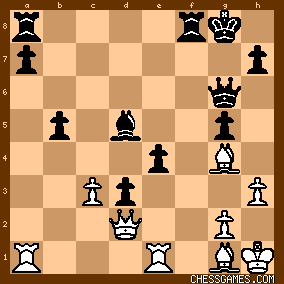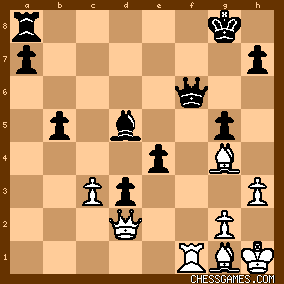|
< Earlier Kibitzing · PAGE 2 OF 2 ·
Later Kibitzing> |
| Aug-29-15 | | Severin: He spent over a half hour on move 17, and it was a game-losing move. |
|
Aug-30-15
 | | Fusilli: <devere> 18.Nxe4 seems pretty complicated, no? If 18...dxe4 19.Bc4+ followed by 20.Be5+. If 18...exf2+ 19.Nxf2 and Black no longer has a strong central pawn. Maybe 17...fxe3 was better, but I am guessing Fabiano may have been bothered by 18.Nxe4. |
|
| Aug-30-15 | | miamihurricane: Fabiano's play has deteriorated.His new manager likes to party too much and keeps Fabiano out late drinking! Not so good at a super tournament! |
|
| Aug-30-15 | | SirRuthless: Very interesting opening play from Grischuk and enterprising sac from Caruana but he played timidly as he often does and was punished. The time trouble addict beats time troubles best friend. |
|
| Aug-30-15 | | Steve.Patzer: I must follow through on 17.... exf3 |
|
| Aug-30-15 | | Markov47: <Fusilli: <devere> 18.Nxe4 seems pretty complicated, no? If 18...dxe4 19.Bc4+ followed by 20.Be5+.> 18.Nxe4 dxe4 19. Bc4+ Rg7 20. Be5+ Rh6 and white is in the way of losing another piece. |
|
Aug-30-15
 | | Fusilli: <Markov47> okay, then why do you think Fabiano didn't play 17...fxe3? |
|
Aug-30-15
 | | PawnSac: < Fusilli: <Markov47> okay, then why do you think Fabiano didn't play 17...fxe3? > The obvious answer:
he thought 17...Nxc5 was better!
The right question is;
Why did Fab think Nxc5 was stronger than fxe3 ?
and the answer probably is that he thought fxe3 would be more decisive with the B on c5, when it would dangerously expose the white king. but ok, he miscalculated and incorrectly assessed the position. |
|
| Aug-31-15 | | NeverAgain: <PawnSac: The obvious answer:
he thought 17...Nxc5 was better!>
This doesn't make any sense. 17...Nxc5 is not even a legal move. |
|
| Sep-30-16 | | Steve.Patzer: Strange that I even thought of 30. Ra6! |
|
| Sep-30-16 | | YouRang: Firday 30.?

click for larger view
It seems that there is a bit of a deflection theme going on lately, where a sac draws a key defender away, allowing another piece to come into the attack with check. Today, I spotted pretty quickly that <30.Rh6!> works in this regard.

click for larger view
- If <30...Qxh6>, black loses rapidly to 31.Qxg5+ Qg6 32.Qxd5+, and the white's bishops and Re1 will soon be swarming black's king. - Ducking the Q with <30...Qg7>, allows 31.Bd4 Qe7 (trying to guard Pg5) 32.Be6+! Bxe6 33.Rxe4 and the Be6 will drop with continuing attack. - Blocking the attack with <30...Rf6> is probably best

click for larger view
But the burden to guard Pg5 is still exploited with <31.Rxf6 Qxf6 32.Rf1!>

click for larger view
- If <32...Qxf1 33.Qxg5+ Kf8 34.Qxd5 Re1 35.Qc5+ Re7 36.Bh5>

click for larger view
We've taken e8 and f7 away, which makes the rook a poor defender, and if the black queen comes back to help, then our DSB joins the attack with Bd4. Haven't worked it all out, but black is in bad shape. |
|
| Sep-30-16 | | stacase: 30.Ra6 is a killer (-: |
|
| Sep-30-16 | | patzer2: Easily found 30. Ra6! for my solution to today's Friday puzzle. However, after 30...Rf6 my follow-up was 31. Bh5 which wins after 31. Bh5 Rxa6 32. Bxg6 Rxg6 + 33. Rf1  (+3.15 @ 20 depth, Deep Fritz 15). (+3.15 @ 20 depth, Deep Fritz 15). The game continuation 31. Rea1  , though winning, is not White's strongest reply. After 31. Rea1 h6 32. Rxa7 Rxa7 , though winning, is not White's strongest reply. After 31. Rea1 h6 32. Rxa7 Rxa7  (+2.80 @ 28 depth, Deep Fritz 15) the evaluation is about the same as for my winning alternative 31. Bh5 (+2.80 @ 28 depth, Deep Fritz 15) the evaluation is about the same as for my winning alternative 31. Bh5  (+3.15 @ 20 depth, Deep Fritz 15). (+3.15 @ 20 depth, Deep Fritz 15). White's strongest follow-up, after 30. Ra6 Rf6, is the simple and straight forward 31. Rxf6 Qxf6 32. Rf1  (+9.23 @ 28 depth, Komodo 9.02). (+9.23 @ 28 depth, Komodo 9.02). For a Black improvement, I like 15... fxe3 16. fxe3 Nxc5 17. dxc5 Bxc5 18. Bg1 Qc7 19. Nf1 Bd6 = (-0.19 @ 21 depth, Deep Fritz 15). |
|
| Sep-30-16 | | agb2002: White has a bishop for three pawns.
Black threatens h5.
The bishop on d5 is defenseless. This suggests 30.Ra6: A) 30... Qxa6 31.Qxg5+ Qg6 (31... Kf7 32.Rf1+ wins; 31... Kh8 32.Bd4+ wins) 32.Qxd5+ Kg7 (32... Rf7 33.Qxa8+ wins; 32... Qf7 33.Be6 wins; 32... Kh8 33.Be5+ wins) 33.Bd4+ Kh6 34.Rxe4 (threatens Bg4 to anywhere and Rh4+) A.1) 34... Rad8 35.Be3+ Kg7 36.Re7+ looks winning. A.2) 34... Rae8 35.Be3+ (35.Be6 is probably simpler) 35... Kg7 36.Qd4+ A.2.a) 36... Rf6 37.Rxe8 Qxe8 38.Qxd3 + - [2B vs R]. A.2.b) 36... Kg8 37.Be6+ Rxe6 38.Rg4 seems to win. A.2.c) 36... Qf6 37.Rxe8 Rxe8 (37... Qxd4 38.Bxd4+ and 39.Rxf8 wins) 38.Bh6+ A.2.c.i) 38... Kxh6 39.Qxf6#.
A.2.c.ii) 38... Kf7 39.Bh5+ Ke7 40.Qxf6+ Kxf6 41.Bxe8 wins. A.2.c.iii) 38... Kg6 39.Bh5+ as in A.2.c.ii.
B) 30... Rf6 31.Rxf6 Qxf6 32.Bd4 looks very good for White. For example, 32... Qe7 33.Rf1 Rf8 (due to Bf6 or Rf6) 34.Bf6 Rxf6 35.Qxg5+ wins. C) 30... Qg7 31.Bd4 Qe7 32.Bf6 as in B.
D) 30... Bc6 31.Rxc6 Qxc6 32.Qxg5+ Qg6 transposes to A. |
|
| Sep-30-16 | | AlicesKnight: With a piece to the good, why does White need to do anything spectacular? Because all those Ps could be a nuisance? So what about 30.Ra6? If...Qxa6, 31.Qxg5+ and if ....Qg6, 32.Qxd5+ with threats of B pins, Rxe4 etc. Let's see - OK< got the start at least. No 'quick' win but Black's counter-chances are gone. |
|
| Sep-30-16 | | gofer: The poor black queen is working hard to protect
against Qxg5+ causing mayhem, but it seems
that her efforts are wasted...
<30 Ra6 ...>
30 ... Qg7
31 Bd4 Qe7
32 Bf6! Rxf6
33 Qxg5+ 
30 ... Qxa6
31 Qxg5+ Qg6
32 Qxd5+ 
<30 ... Rf6>
<31 Rxf6 Qxf6>
<32 Rf1! Qxf1>
<33 Qxg5+ Kf8> (Kh8 Kh2  or Kf7 Qxd5 or Kf7 Qxd5  ) ) <34 Qxd5  > >

click for larger view~~~
Hmmm, well on the same lines as <YouRang>, but with slightly less typos... ...except that after <34 ... Re8> I was going to continue with <34 Qd6+>
controlling the b8-h2 diagonal and was then planning to play <35 Kh2> freeing up Bg1 which would make black's life even more difficult... |
|
| Sep-30-16 | | diagonalley: well, as did many others, i went for 30.R-R6 ...but the follow-up lines are quite protracted... so i would rate this harder than "difficult" |
|
Sep-30-16
 | | steinitzfan: Here's an interesting variation from Fritz: After 30 Ra6, Rf6; 31 Rxf6, Qxf6 -- 32 Rxe4 gets high marks. If Black takes the rook then 33 Qa2+, Kf8; 34 Bc5+, Ke8; 35 Qg8+ and mates. So if Black doesn't take the rook, then White has - what? Won a pawn? The evaluation stands at  4 so there must be more than that. The follow-up seems to require a lot of odd moves though. 32 Rf1 evaluates higher ( 4 so there must be more than that. The follow-up seems to require a lot of odd moves though. 32 Rf1 evaluates higher (  5) and the moves seem a little more meaningful when I watch them. 5) and the moves seem a little more meaningful when I watch them. |
|
| Sep-30-16 | | Lambda: I think once you've seen the Qxg5 Qxd5 idea, this one is a move you can select by instinct, rather than feeling the need to calculate what you do next. |
|
| Sep-30-16 | | dfcx: Material is even, white has an extra bishop against black's three extra pawns. The black queen is critical in defending the g5 pawn - let's deflect it! 30.Ra6! Qxa6? 31.Qxg5+ Qg6 32.Qxd5+ and black can't defend the queen and 2 bishops attacks. If black defends against with
30.Ra6 Rf6 31.Rxf6 Qxf6 32,Rxe4 looks promising. |
|
| Sep-30-16 | | YouRang: <Lambda: I think once you've seen the Qxg5 Qxd5 idea, this one is a move you can select by instinct, rather than feeling the need to calculate what you do next.> I agree. Once you see that your rook is safe after 30.Ra6 (and black has no clever counter-attack), you can play it without calculating all the variations. Basically, you've turned your idle rook into a strong attacker for free (i.e. without having to go to the trouble of guarding it because it's defended tactically), so it's got to be good. |
|
| Sep-30-16 | | kevin86: The final threats are from a queen in the corner! |
|
| Sep-30-16 | | Aunt Jemima: I got 30. Ra6 and saw that if ...Qxa6 31. Qxg5+ wins. I didn't see the game continuation though and when black interposed the rook, I thought of defending the R on a6 with Ra1 just as white played. I'm not sure if I get credit for this or not. |
|
| Oct-01-16 | | MaczynskiPratten: I was wondering initially why Black resigned after 40.. b4 as he has successfully blocked White's planned Queen check on the a3-f8 diagonal. The answer is that after 41 axb4 it is now the Bishop check on this diagonal 42 Bc5+ that will be decisive, as the White Qa1 now guards the Rg7. A neat swap of roles! Also an illustration of how opposite coloured Bishops in a middlegame can be dangerous - here Black faces disaster on the black squared diagonals. |
|
| Dec-10-16 | | Caissanist: FWIW, black didn't actually resign, he lost on time. He made his 40th move in time so it was recorded, but in the time it took him to punch his clock he used up his last second: https://www.chess.com/news/nakamura... . |
|
 |
|
< Earlier Kibitzing · PAGE 2 OF 2 ·
Later Kibitzing> |





